-
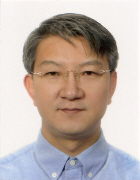 Professor Lee Sang Yeop Nominated the Chairman of Emerging Technologies Global Agenda Council of the World Economic Forum
Professor Lee Sang Yeop, Dean of College Life Science & Bioengineering, was appointed as the chairman of the Emerging Technologies Global Agenda Council of the World Economic Forum.
He will be in office till the 31st of August 2012, exactly 1 year from the date of his appointment.
The World Economic Forum (WEF) is a ‘think tank’ consisting of world leaders in various fields like economics, politics, and policies and has created the ‘Global Agenda Council’ to solve the problems mankind faces in achieving environmentally sustainable growth and suggest a collective vision and strategy.
The committee to be chaired by Professor Lee (Emerging Technologies Global Agenda Council) will discuss the direction in which the fields of biological engineering, nanotechnology, and IT (information technology) should develop and discuss the possible impact these fields will have on the society.
Professor Lee commented that, “I am extremely happy to be appointed as the chair of the Emerging Technologies Global Agenda Council at the World Economic Forum which is a gathering of world class leaders” and that “it is a great opportunity to spread Korea’s success and lessons in the advancement of science and technology.”
Professor Lee is the creator of the field of system metabolism engineering and is making great strides in manipulating the microorganism’s metabolic pathways on a systems scale to make changing chemicals derived from oil into eco-friendly and bio-based products.
2011.09.20 View 9010
Professor Lee Sang Yeop Nominated the Chairman of Emerging Technologies Global Agenda Council of the World Economic Forum
Professor Lee Sang Yeop, Dean of College Life Science & Bioengineering, was appointed as the chairman of the Emerging Technologies Global Agenda Council of the World Economic Forum.
He will be in office till the 31st of August 2012, exactly 1 year from the date of his appointment.
The World Economic Forum (WEF) is a ‘think tank’ consisting of world leaders in various fields like economics, politics, and policies and has created the ‘Global Agenda Council’ to solve the problems mankind faces in achieving environmentally sustainable growth and suggest a collective vision and strategy.
The committee to be chaired by Professor Lee (Emerging Technologies Global Agenda Council) will discuss the direction in which the fields of biological engineering, nanotechnology, and IT (information technology) should develop and discuss the possible impact these fields will have on the society.
Professor Lee commented that, “I am extremely happy to be appointed as the chair of the Emerging Technologies Global Agenda Council at the World Economic Forum which is a gathering of world class leaders” and that “it is a great opportunity to spread Korea’s success and lessons in the advancement of science and technology.”
Professor Lee is the creator of the field of system metabolism engineering and is making great strides in manipulating the microorganism’s metabolic pathways on a systems scale to make changing chemicals derived from oil into eco-friendly and bio-based products.
2011.09.20 View 9010 -
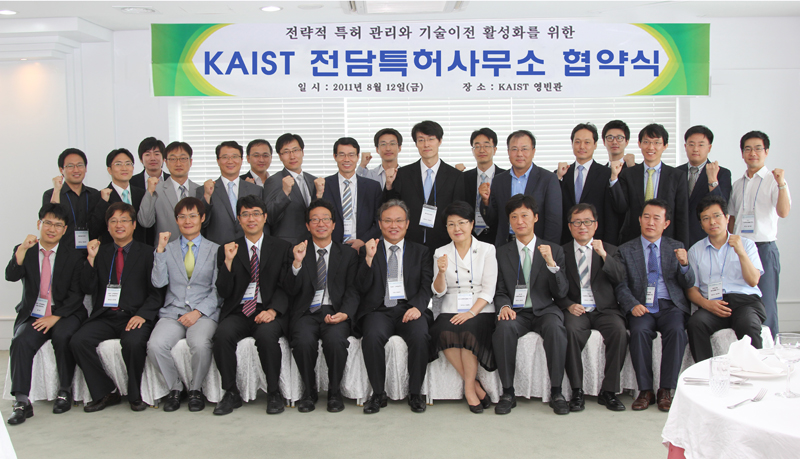 KAIST Began to Operate 20 Specialized Patent Offices
KAIST’s Industry-University Collaboration Team started the operation of 20 specialized patent offices in order to improve the efficiency and specialty of patenting and commercialization of research results of KAIST. With the start of the operation of the patent offices, KAIST now has laid the groundwork for creating patent rights and improved patent use through improving services for technology developers and inventors.
The patent offices will offer various types of support related to patent rights and technology transfer by providing services such as interviews with inventors, preliminary reviews of technologies, and evaluations to find the invented technology patents worthwhile.
KAIST overwhelmingly outpaced other universities in the nation and ranked the “number one research university” in patent ownerships. According to the Korean Intellectual Property Office that investigated the number of patents domestic universities had acquired over the period of 5 years from 2006 to 2010, KAIST had 4,403 patents and was named the first in the fields of information and communication, electric materials and semiconductors, electronic circuit, automobile, and inorganic chemistry.
2011.09.20 View 7060
KAIST Began to Operate 20 Specialized Patent Offices
KAIST’s Industry-University Collaboration Team started the operation of 20 specialized patent offices in order to improve the efficiency and specialty of patenting and commercialization of research results of KAIST. With the start of the operation of the patent offices, KAIST now has laid the groundwork for creating patent rights and improved patent use through improving services for technology developers and inventors.
The patent offices will offer various types of support related to patent rights and technology transfer by providing services such as interviews with inventors, preliminary reviews of technologies, and evaluations to find the invented technology patents worthwhile.
KAIST overwhelmingly outpaced other universities in the nation and ranked the “number one research university” in patent ownerships. According to the Korean Intellectual Property Office that investigated the number of patents domestic universities had acquired over the period of 5 years from 2006 to 2010, KAIST had 4,403 patents and was named the first in the fields of information and communication, electric materials and semiconductors, electronic circuit, automobile, and inorganic chemistry.
2011.09.20 View 7060 -
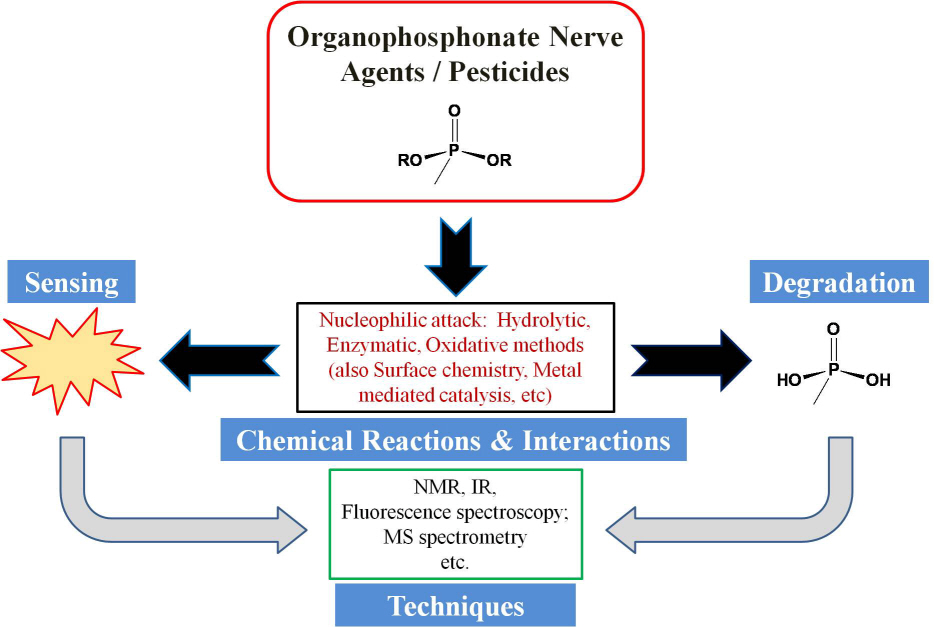 Review of organophosphonate nerve agent remediation and sensing chemistry
Professor David Churchill, Dept. of Chemistry, KAIST
Scientists in Daejeon, South Korea and Lexington, Kentucky (USA) have recently published a review on the subject of nerve agent remediation and probing chemistry (Chemical Reviews, DOI:10.1021/cr100193y). This article endeavored to pursue organophosphonate nerve agent chemistry deeply and comprehensively and to reflect that decontamination / sensing and nerve agents / pesticides are quite inextricable: when one tries to degrade nerve agents one also needs to detect what components are still present “downstream,” etc. Nerve agents and many pesticides also share a common generalized organophosphate / -phosphonate structure.
Also, the use of simulant molecules (mimics) and a consideration of the closely related organophosphonate pesticides were also treated comprehensively in the Review. The authors reached back into the literature when developing some sections to make important connections to the contemporary topics of interest. The review also includes industrial insights.
Kibong Kim, Olga G. Tsay and David G. Churchill of the Department of Chemistry at KAIST and David A. Atwood of the Department of Chemistry of the University of Kentucky endeavored to "make a variety of connections in research strategies and (sub-) fields to present what is still possible, fruitful, practical, and necessary and to facilitate a current comprehensive molecular level understanding of organophosphonate degradation and sensing," Churchill says.
The authors feel that for the time being, researchers in varying research areas “can use this manuscript effectively when considering future research directions.”
2011.09.19 View 8402
Review of organophosphonate nerve agent remediation and sensing chemistry
Professor David Churchill, Dept. of Chemistry, KAIST
Scientists in Daejeon, South Korea and Lexington, Kentucky (USA) have recently published a review on the subject of nerve agent remediation and probing chemistry (Chemical Reviews, DOI:10.1021/cr100193y). This article endeavored to pursue organophosphonate nerve agent chemistry deeply and comprehensively and to reflect that decontamination / sensing and nerve agents / pesticides are quite inextricable: when one tries to degrade nerve agents one also needs to detect what components are still present “downstream,” etc. Nerve agents and many pesticides also share a common generalized organophosphate / -phosphonate structure.
Also, the use of simulant molecules (mimics) and a consideration of the closely related organophosphonate pesticides were also treated comprehensively in the Review. The authors reached back into the literature when developing some sections to make important connections to the contemporary topics of interest. The review also includes industrial insights.
Kibong Kim, Olga G. Tsay and David G. Churchill of the Department of Chemistry at KAIST and David A. Atwood of the Department of Chemistry of the University of Kentucky endeavored to "make a variety of connections in research strategies and (sub-) fields to present what is still possible, fruitful, practical, and necessary and to facilitate a current comprehensive molecular level understanding of organophosphonate degradation and sensing," Churchill says.
The authors feel that for the time being, researchers in varying research areas “can use this manuscript effectively when considering future research directions.”
2011.09.19 View 8402 -
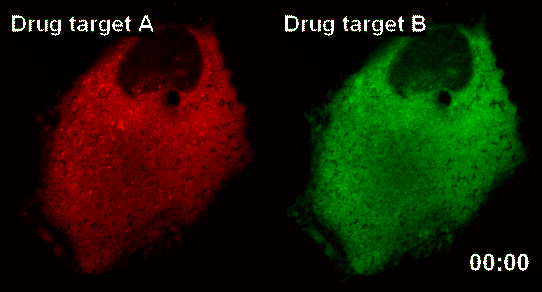 New Technology Developed for Analysis of New Drugs by Using Smart Nano-Sensors
Doctor Sang-Kyu Lee
Doctor Sang-Kyu Lee of the Department of Biological Sciences, KAIST, has developed the technology that allows biological nano particles to be implanted into human cells for monitoring the effect of new drugs in real time from within the cell. It is expected that this technology will boost the ability to weigh the effects and properties of a new drug more quickly and accurately.
Conventionally, the candidate drug was injected into the human body, and then its cells are extracted to analyze the effects of the drugs. The problem with this method was that the cells were analyzed at a ‘dead’ state which made it incredibly difficult to find candidate substances due to uncontrollable side effects. This made the development of new drugs very difficult despite the large costs and efforts invested into its development.
The research team latched onto the idea that nanoparticles can connect to form a large complex. The complex acts as a nanosensor which allows for real time observation of drug target and the drug itself binding.
The team named the nanosensor technology ‘InCell SMART-i’ and was named ‘Hot Paper’ of the September edition of ‘Angewandte Chemie International Edition’ magazine, a world famous Chemistry Magazine.When a new drug injected into the human body, the drug and drug targets are gradually combined, and the smart nanosensor detects in real time the effect of the new drug as shown in the pictures above (shaded spot).
2011.09.19 View 9033
New Technology Developed for Analysis of New Drugs by Using Smart Nano-Sensors
Doctor Sang-Kyu Lee
Doctor Sang-Kyu Lee of the Department of Biological Sciences, KAIST, has developed the technology that allows biological nano particles to be implanted into human cells for monitoring the effect of new drugs in real time from within the cell. It is expected that this technology will boost the ability to weigh the effects and properties of a new drug more quickly and accurately.
Conventionally, the candidate drug was injected into the human body, and then its cells are extracted to analyze the effects of the drugs. The problem with this method was that the cells were analyzed at a ‘dead’ state which made it incredibly difficult to find candidate substances due to uncontrollable side effects. This made the development of new drugs very difficult despite the large costs and efforts invested into its development.
The research team latched onto the idea that nanoparticles can connect to form a large complex. The complex acts as a nanosensor which allows for real time observation of drug target and the drug itself binding.
The team named the nanosensor technology ‘InCell SMART-i’ and was named ‘Hot Paper’ of the September edition of ‘Angewandte Chemie International Edition’ magazine, a world famous Chemistry Magazine.When a new drug injected into the human body, the drug and drug targets are gradually combined, and the smart nanosensor detects in real time the effect of the new drug as shown in the pictures above (shaded spot).
2011.09.19 View 9033 -
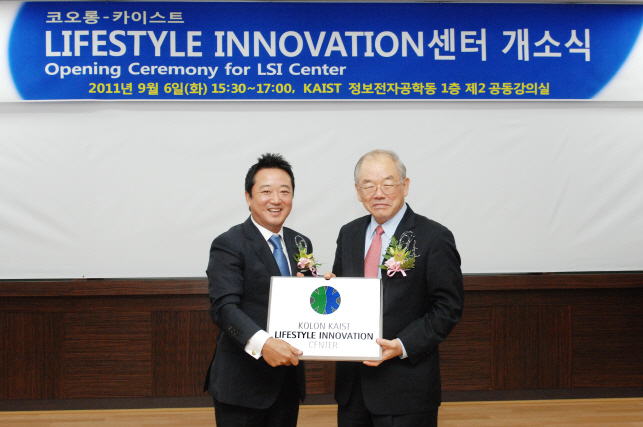 KOLON-KAIST Lifestyle Innovation Center Opening Ceremony
KAIST and KOLON opened the “Lifestyle Innovation Center” on the 6th of September this year. The ceremony was held at KAIST where the MOU for developing new industries was also signed.
The opening ceremony was attended by Chairman of KOLON Lee Eung Yeul and CEO’s of other various affiliate companies like Kim Nam Soo, Bae Young Ho, Park Dong Moon, and etc. and also President of KAIST Seo Nam Pyo along with professors who will participate like Professor Lee Young Hoon, Professor Joo Dae Joon, Professor Bae Kyung Wook, and Vice President of KAIST Jo Dong Ho.
The KOLON-KAIST Lifestyle Innovation Center (referred to as KOLON LSI Center) was developed under instructions from Chairman of KOLON Lee Eung Yeul wishing for the active cooperation and transfers of technologies with KAIST and, as a result, creating a domestic technology transfer network. The two institutes will be working together in finding highly promising fields of industry (with high risk but also high return) through research and development, technological advices, competitive exhibitions, and workshops.
Chairman of KOLON Lee Eung Yeul stated that “it is imperative to increase the success rate of new business and shorten the time frame of starting a new business by encouraging the business community to launch startups more and for the executive community including policy makers to support such endeavors” and that “the KOLON LSI Center will create a positive synergy to that end.”
President Seo Nam Pyo commented that, “KOLON-KAIST LSI Center is different even at the conceptual level” and that “I am confident that it will be a great success as it is the first of specialized joint labs in Korea that encourages professors and researchers of companies to conduct joint research programs.”
LSI Center was founded and will be administered by the Collective Contribution from KOLON, KOLON Industry, and KOLON GloTech, investing 7.5billion Korean Won over the course of 5 years.
2011.09.19 View 10212
KOLON-KAIST Lifestyle Innovation Center Opening Ceremony
KAIST and KOLON opened the “Lifestyle Innovation Center” on the 6th of September this year. The ceremony was held at KAIST where the MOU for developing new industries was also signed.
The opening ceremony was attended by Chairman of KOLON Lee Eung Yeul and CEO’s of other various affiliate companies like Kim Nam Soo, Bae Young Ho, Park Dong Moon, and etc. and also President of KAIST Seo Nam Pyo along with professors who will participate like Professor Lee Young Hoon, Professor Joo Dae Joon, Professor Bae Kyung Wook, and Vice President of KAIST Jo Dong Ho.
The KOLON-KAIST Lifestyle Innovation Center (referred to as KOLON LSI Center) was developed under instructions from Chairman of KOLON Lee Eung Yeul wishing for the active cooperation and transfers of technologies with KAIST and, as a result, creating a domestic technology transfer network. The two institutes will be working together in finding highly promising fields of industry (with high risk but also high return) through research and development, technological advices, competitive exhibitions, and workshops.
Chairman of KOLON Lee Eung Yeul stated that “it is imperative to increase the success rate of new business and shorten the time frame of starting a new business by encouraging the business community to launch startups more and for the executive community including policy makers to support such endeavors” and that “the KOLON LSI Center will create a positive synergy to that end.”
President Seo Nam Pyo commented that, “KOLON-KAIST LSI Center is different even at the conceptual level” and that “I am confident that it will be a great success as it is the first of specialized joint labs in Korea that encourages professors and researchers of companies to conduct joint research programs.”
LSI Center was founded and will be administered by the Collective Contribution from KOLON, KOLON Industry, and KOLON GloTech, investing 7.5billion Korean Won over the course of 5 years.
2011.09.19 View 10212 -
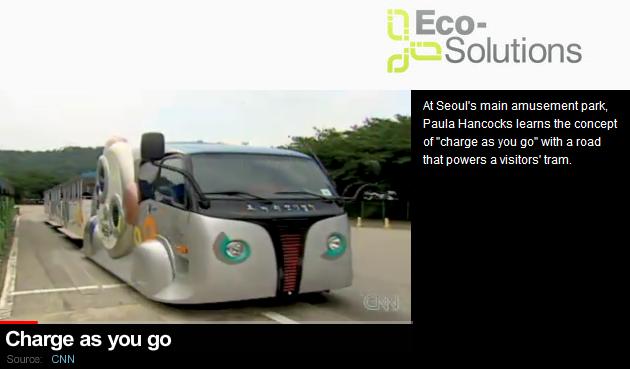 KAIST Online Electirc Vehicle Introduced by CNN
CNN aired KAIST’s Online Electric Vehicle (OLEV) on August 29, 2011 in its program called “Eco Solutions” that reports on meeting people with innovative solutions to preserve the planet. The reporter went to Seoul Grand Park, an amusement park and introduced an online electric tram developed by KAIST and operated on a daily basis for park visitors since July 29, 2011. KAIST has designed different types of OLEVs including bus, SUV, and tram. The reporter said that “the online electric tram” at the park provides visitors with a “cleaner, greener, and convenience since it charges as you go.” Currently, three OLEVs are running inside the park, and KAIST plans to replace the rest of existing diesel trams with OLEVs in the near future.
CNN Link: http://edition.cnn.com/CNNI/Programs/eco.solutions/index.html
Youtube Link: http://www.youtube.com/watch?v=QLzmFFqPJfo
2011.09.09 View 9799
KAIST Online Electirc Vehicle Introduced by CNN
CNN aired KAIST’s Online Electric Vehicle (OLEV) on August 29, 2011 in its program called “Eco Solutions” that reports on meeting people with innovative solutions to preserve the planet. The reporter went to Seoul Grand Park, an amusement park and introduced an online electric tram developed by KAIST and operated on a daily basis for park visitors since July 29, 2011. KAIST has designed different types of OLEVs including bus, SUV, and tram. The reporter said that “the online electric tram” at the park provides visitors with a “cleaner, greener, and convenience since it charges as you go.” Currently, three OLEVs are running inside the park, and KAIST plans to replace the rest of existing diesel trams with OLEVs in the near future.
CNN Link: http://edition.cnn.com/CNNI/Programs/eco.solutions/index.html
Youtube Link: http://www.youtube.com/watch?v=QLzmFFqPJfo
2011.09.09 View 9799 -
 Op-Ed by MIT President, Manufacturing a Recovery, New York Times, August 29, 2011
New York Times carried an opinion piece of MIT President, Susan Hockfield. Dr. Hockfield put emphasis on the importance of recovering manufacturing to revive the US economy and suggested investments in the development of high technology and “tight integration of design production” through “networks of innovation, lab research to new production processes, and business models.” For the op-ed piece, please go to
http://www.nytimes.com/2011/08/30/opinion/manufacturing-a-recovery.html?_r=2.
2011.08.31 View 9640
Op-Ed by MIT President, Manufacturing a Recovery, New York Times, August 29, 2011
New York Times carried an opinion piece of MIT President, Susan Hockfield. Dr. Hockfield put emphasis on the importance of recovering manufacturing to revive the US economy and suggested investments in the development of high technology and “tight integration of design production” through “networks of innovation, lab research to new production processes, and business models.” For the op-ed piece, please go to
http://www.nytimes.com/2011/08/30/opinion/manufacturing-a-recovery.html?_r=2.
2011.08.31 View 9640 -
 Future of Petrochemical Industry: The Age of Bio-Refineries
The concept of bio-refinery is based on using biomass from seaweeds and non-edible plant sources to produce various materials.
Bio-refineries has been looked into with increasing interest in modern times due to the advent of global warming (and the subsequent changes in the atmosphere) and the exhaustion of natural resources.
However past 20 years of research in metabolic engineering had a crucial limitation; the need to improve the efficiency of the microorganisms that actually go about converting biomass into biochemical materials.
In order to compensate for the inefficiency, Professor Lee Sang Yeop combined systems biology, composite biology, evolutionary engineering to form ‘systems metabolic engineering’.
This allows combining various data to explain the organism’s state in a multi-dimensional scope and respond accordingly by controlling the metabolism.
The result of the experiment is set as the cover dissertation of ‘Trends in Biotechnology’ magazine’s August edition.
2011.07.28 View 10806
Future of Petrochemical Industry: The Age of Bio-Refineries
The concept of bio-refinery is based on using biomass from seaweeds and non-edible plant sources to produce various materials.
Bio-refineries has been looked into with increasing interest in modern times due to the advent of global warming (and the subsequent changes in the atmosphere) and the exhaustion of natural resources.
However past 20 years of research in metabolic engineering had a crucial limitation; the need to improve the efficiency of the microorganisms that actually go about converting biomass into biochemical materials.
In order to compensate for the inefficiency, Professor Lee Sang Yeop combined systems biology, composite biology, evolutionary engineering to form ‘systems metabolic engineering’.
This allows combining various data to explain the organism’s state in a multi-dimensional scope and respond accordingly by controlling the metabolism.
The result of the experiment is set as the cover dissertation of ‘Trends in Biotechnology’ magazine’s August edition.
2011.07.28 View 10806 -
 Spintronics: A high wire act by Nanowerk News
An article by Nanowerk News on the integration of ferromagnetic nanowire arrays on grapheme substrates was published. Professor Bong-Soo Kim from the Department of Chemistry, KAIST, led the research in conjunction with Hanyang University and Samsung in Korea.
http://www.nanowerk.com/news/newsid=22204.php
Posted: Jul 25th, 2011
Spintronics: A high wire act
(Nanowerk News) Graphene is a promising material for a wide range of applications due to its remarkable mechanical and electronic properties. An application of particular interest is spin-based electronics, or spintronics, in which the spin orientation of an electron is used to perform circuit functions in addition to its charge. Bongsoo Kim and colleagues from KAIST, Hanyang University and Samsung in Korea now report the integration of ferromagnetic nanowire arrays on graphene substrates, opening up a route for the construction of graphene-based spintronic devices using nanowires as spin-injecting contacts ("Epitaxially Integrating Ferromagnetic Fe1.3Ge Nanowire Arrays on Few-Layer Graphene").
The spin of an electron is a property that, like charge, can be used to encode, process and transport information. However, spin information is easily lost in most media, which has made spintronics difficult to realize in practice. In graphene, on the other hand, spin can be preserved for longer due to its peculiar electron transport properties. "Low intrinsic spin–orbit coupling, long spin diffusion lengths and vanishing hyperfine interaction are features of graphene that make it a promising medium for spin transport," explains Kim.
Scanning electron microscopy image of vertical iron germanide nanowires grown on graphene. (© ACS 2011)
A prerequisite for the realization of spintronic devices based on graphene is its integration with ferromagnetic contacts to allow spin injection. Kim and his co-workers found that nanowires of iron germanide (Fe1.3Ge) serve as efficient contacts for this purpose. "Iron germanide nanowires show low resistivity and room-temperature ferromagnetism, and they are compatible with existing complementary metal–oxide–semiconductor technologies," says Kim.
To produce the atomically well-defined interfacial contact between the nanowires and the graphene surface needed for optimum device performance, the researchers deposited the contacts by an epitaxial method based on chemical vapor transport. Through careful adjustment of deposition parameters such as carrier gas flow rate and reaction temperature, the researchers produced vertically aligned nanowires that are closely lattice-matched to the graphene sheets (see image).
Initially preparing the graphene sheets on a substrate of silicon oxide allowed the researchers to isolate the final nanowire–graphene structure by etching and then transfer it to another substrate, greatly expanding the versatility of the approach. It is a delicate process, however. "It is necessary to transfer the graphene films onto the substrate very carefully in order to avoid folding and wrinkling of the graphene," says Kim.
Source: Tokyo Institute of Technology
2011.07.26 View 10293
Spintronics: A high wire act by Nanowerk News
An article by Nanowerk News on the integration of ferromagnetic nanowire arrays on grapheme substrates was published. Professor Bong-Soo Kim from the Department of Chemistry, KAIST, led the research in conjunction with Hanyang University and Samsung in Korea.
http://www.nanowerk.com/news/newsid=22204.php
Posted: Jul 25th, 2011
Spintronics: A high wire act
(Nanowerk News) Graphene is a promising material for a wide range of applications due to its remarkable mechanical and electronic properties. An application of particular interest is spin-based electronics, or spintronics, in which the spin orientation of an electron is used to perform circuit functions in addition to its charge. Bongsoo Kim and colleagues from KAIST, Hanyang University and Samsung in Korea now report the integration of ferromagnetic nanowire arrays on graphene substrates, opening up a route for the construction of graphene-based spintronic devices using nanowires as spin-injecting contacts ("Epitaxially Integrating Ferromagnetic Fe1.3Ge Nanowire Arrays on Few-Layer Graphene").
The spin of an electron is a property that, like charge, can be used to encode, process and transport information. However, spin information is easily lost in most media, which has made spintronics difficult to realize in practice. In graphene, on the other hand, spin can be preserved for longer due to its peculiar electron transport properties. "Low intrinsic spin–orbit coupling, long spin diffusion lengths and vanishing hyperfine interaction are features of graphene that make it a promising medium for spin transport," explains Kim.
Scanning electron microscopy image of vertical iron germanide nanowires grown on graphene. (© ACS 2011)
A prerequisite for the realization of spintronic devices based on graphene is its integration with ferromagnetic contacts to allow spin injection. Kim and his co-workers found that nanowires of iron germanide (Fe1.3Ge) serve as efficient contacts for this purpose. "Iron germanide nanowires show low resistivity and room-temperature ferromagnetism, and they are compatible with existing complementary metal–oxide–semiconductor technologies," says Kim.
To produce the atomically well-defined interfacial contact between the nanowires and the graphene surface needed for optimum device performance, the researchers deposited the contacts by an epitaxial method based on chemical vapor transport. Through careful adjustment of deposition parameters such as carrier gas flow rate and reaction temperature, the researchers produced vertically aligned nanowires that are closely lattice-matched to the graphene sheets (see image).
Initially preparing the graphene sheets on a substrate of silicon oxide allowed the researchers to isolate the final nanowire–graphene structure by etching and then transfer it to another substrate, greatly expanding the versatility of the approach. It is a delicate process, however. "It is necessary to transfer the graphene films onto the substrate very carefully in order to avoid folding and wrinkling of the graphene," says Kim.
Source: Tokyo Institute of Technology
2011.07.26 View 10293 -
 Wireless electric trams at Seoul Amusement Park begin full operations.
Photo by Hyung-Joon Jun
IMMEDIATE RELEASE
Wireless electric trams at Seoul Amusement Park begin full operations.
KAIST’s On-Line Electric Vehicle (OLEV) becomes an icon of green technology, particularly for young students who aspire to transform their nation into the “vanguard of sustainability.”
Seoul, South Korea, July 19, 2011—As young students wrap up their school work before summer vacation in late July, Seoul Grand Park, an amusement park located south of Seoul, is busily preparing to accommodate throngs of summer visitors. Among the park’s routine preparations, however, there is something new to introduce to guests this summer: three wireless electric trams have replaced the old diesel-powered carts used by passengers for transportation within the park.
The Korea Advanced Institute of Science and Technology (KAIST) and the city of Seoul held a ceremony this morning, July 19, 2011, to celebrate their joint efforts to adopt a green public transportation system and presented park visitors with the three On-Line Electric Vehicles (OLEVs), which will be operated immediately thereafter. Approximately one hundred people, including science high school students across the nation, attended the ceremony and had a chance to ride the trams.
KAIST unveiled the prototype of an electric tram to the public in March 2010, and since then it has developed three commercial trams. The Korean government and the institute have worked on legal issues to embark on the full-scale commercialization of OLEV, and the long awaited approval from the government on such issues as standardization of the OLEV technology and road infrastructure, regulation of electromagnetic fields and electricity safety, and license and permits for vehicle eligibility, finally came through.
The On-Line Electric Vehicle (OLEV) is no ordinary electric car in that it is remotely charged via electromagnetic fields created by electric cables buried beneath the road. Unlike other currently available electric cars, OLEV can travel unlimited distances without having to stop to recharge. OLEV also has a small battery onboard, which enables the vehicle to travel on roads that are not equipped with underground power cables. This battery, however, is only one-fifth of the size of a conventional electric vehicle battery, resulting in considerable savings in the cost, size, and weight of the vehicle.
The OLEV project was initiated in 2009 as a method of resolving the battery problems of electric cars in a creative and disruptive way. KAIST came up with the idea of supplying electricity directly to the cars instead of depending solely on the onboard battery for power. Since then, the university has developed core technologies related to OLEV such as the “Shaped Magnetic Field in Resonance (SMFIR),” which enables an electric car to collect the magnetic fields and convert them into electricity, and the “Segment Technology,” which controls the flow of electromagnetic waves through an automatic power-on/shut-down system, thereby eliminating accidental exposure of the electromagnetic waves to pedestrians or non-OLEV cars.
According to KAIST, three types of OLEV have been developed thus far: electric buses, trams, and sport utility vehicles (SUVs). The technical specifications of the most recently developed OLEV (an electric bus), the OLEV research team at the university said, are as follows:
· Power cables are buried 15cm beneath the road surface.
· On average, over 80% power transmission efficiency is achieved.
· The distance gap between the road surface and the underbody of the vehicle is 20cm.
· The OLEV bus has a maximum electricity pickup capacity of 100kW.
· The OLEV bus complies with international standards for electromagnetic fields (below 24.1 mG).
The eco-friendly electric trams at Seoul Grand Park consume no fossil fuels and do not require any overhead wires or cables. Out of the total circular driving route (2.2km), only 16% of the road, 372.5m, has the embedded power lines, indicating that OLEV does not require extensive reconstruction of the road infrastructure. The city government of Seoul signed a memorandum of understanding with KAIST in 2009 as part of its initiatives to curtail emissions from public transportation and provide cleaner air to its citizens. Both parties plan to expand such collaboration to other transportation systems including buses in the future.
KAIST expects the OLEV technology to be applied in industries ranging from transportation to electronics, aviation, maritime transportation, robotics, and leisure. There are several ongoing international collaborative projects to utilize the OLEV technology for a variety of transportation needs, such as inner city commute systems (bus and trolley) and airport shuttle buses, in nations including Malaysia, US, Germany, and Denmark.
# # #
More information about KAIST’s On-Line Electric Vehicle can be found at http://olev.co.kr/en/index.php. For any inquiries, please contact Lan Yoon at 82-42-350-2295 (cell: 82-10-2539-4303) or by email at hlyoon@kaist.ac.kr.
2011.07.22 View 14522
Wireless electric trams at Seoul Amusement Park begin full operations.
Photo by Hyung-Joon Jun
IMMEDIATE RELEASE
Wireless electric trams at Seoul Amusement Park begin full operations.
KAIST’s On-Line Electric Vehicle (OLEV) becomes an icon of green technology, particularly for young students who aspire to transform their nation into the “vanguard of sustainability.”
Seoul, South Korea, July 19, 2011—As young students wrap up their school work before summer vacation in late July, Seoul Grand Park, an amusement park located south of Seoul, is busily preparing to accommodate throngs of summer visitors. Among the park’s routine preparations, however, there is something new to introduce to guests this summer: three wireless electric trams have replaced the old diesel-powered carts used by passengers for transportation within the park.
The Korea Advanced Institute of Science and Technology (KAIST) and the city of Seoul held a ceremony this morning, July 19, 2011, to celebrate their joint efforts to adopt a green public transportation system and presented park visitors with the three On-Line Electric Vehicles (OLEVs), which will be operated immediately thereafter. Approximately one hundred people, including science high school students across the nation, attended the ceremony and had a chance to ride the trams.
KAIST unveiled the prototype of an electric tram to the public in March 2010, and since then it has developed three commercial trams. The Korean government and the institute have worked on legal issues to embark on the full-scale commercialization of OLEV, and the long awaited approval from the government on such issues as standardization of the OLEV technology and road infrastructure, regulation of electromagnetic fields and electricity safety, and license and permits for vehicle eligibility, finally came through.
The On-Line Electric Vehicle (OLEV) is no ordinary electric car in that it is remotely charged via electromagnetic fields created by electric cables buried beneath the road. Unlike other currently available electric cars, OLEV can travel unlimited distances without having to stop to recharge. OLEV also has a small battery onboard, which enables the vehicle to travel on roads that are not equipped with underground power cables. This battery, however, is only one-fifth of the size of a conventional electric vehicle battery, resulting in considerable savings in the cost, size, and weight of the vehicle.
The OLEV project was initiated in 2009 as a method of resolving the battery problems of electric cars in a creative and disruptive way. KAIST came up with the idea of supplying electricity directly to the cars instead of depending solely on the onboard battery for power. Since then, the university has developed core technologies related to OLEV such as the “Shaped Magnetic Field in Resonance (SMFIR),” which enables an electric car to collect the magnetic fields and convert them into electricity, and the “Segment Technology,” which controls the flow of electromagnetic waves through an automatic power-on/shut-down system, thereby eliminating accidental exposure of the electromagnetic waves to pedestrians or non-OLEV cars.
According to KAIST, three types of OLEV have been developed thus far: electric buses, trams, and sport utility vehicles (SUVs). The technical specifications of the most recently developed OLEV (an electric bus), the OLEV research team at the university said, are as follows:
· Power cables are buried 15cm beneath the road surface.
· On average, over 80% power transmission efficiency is achieved.
· The distance gap between the road surface and the underbody of the vehicle is 20cm.
· The OLEV bus has a maximum electricity pickup capacity of 100kW.
· The OLEV bus complies with international standards for electromagnetic fields (below 24.1 mG).
The eco-friendly electric trams at Seoul Grand Park consume no fossil fuels and do not require any overhead wires or cables. Out of the total circular driving route (2.2km), only 16% of the road, 372.5m, has the embedded power lines, indicating that OLEV does not require extensive reconstruction of the road infrastructure. The city government of Seoul signed a memorandum of understanding with KAIST in 2009 as part of its initiatives to curtail emissions from public transportation and provide cleaner air to its citizens. Both parties plan to expand such collaboration to other transportation systems including buses in the future.
KAIST expects the OLEV technology to be applied in industries ranging from transportation to electronics, aviation, maritime transportation, robotics, and leisure. There are several ongoing international collaborative projects to utilize the OLEV technology for a variety of transportation needs, such as inner city commute systems (bus and trolley) and airport shuttle buses, in nations including Malaysia, US, Germany, and Denmark.
# # #
More information about KAIST’s On-Line Electric Vehicle can be found at http://olev.co.kr/en/index.php. For any inquiries, please contact Lan Yoon at 82-42-350-2295 (cell: 82-10-2539-4303) or by email at hlyoon@kaist.ac.kr.
2011.07.22 View 14522 -
 Scientists develop highly efficient industrial catalyst
http://english.yonhapnews.co.kr/business/2011/07/14/48/0501000000AEN20110714009600320F.HTML
SEOUL, July 15 (Yonhap) -- South Korean scientists said Friday that they have developed a highly efficient nanoporous industrial catalyst that can have a considerable impact on chemical and oil-refining sectors.
The team of scientists led by Ryoo Ryong, a chemistry professor at the Korea Advanced Institute of Science and Technology (KAIST), said the solid zeolite compound developed in the laboratory has a reaction speed five to 10 times faster than that of conventional materials.
Zeolite, which is made from silica and aluminium, is frequently used as an absorbent, water purifier and in nuclear reprocessing, although it is mainly employed in the chemical industry.
The annual size of the zeolite market is estimated at US$2.5 billion with output using the material topping $30 billion. At present, 41 percent of all catalysts used in the chemical sector are nano-scale zeolite materials.
The KAIST team said that because the new zeolite is made up of different sized pores, the material can be used as a catalyst when existing materials are unable to act as a changing agent.
"Existing zeolites only have pores under 1 nanometer in diameter, but the new material has holes that range from 1 nanometer to 3.5 nanometers, which are all arranged in a regular honeycomb arrangement," Ryoo said. A nanometer is one-billionth of a meter.
He said the ability to have both micro- and meso-sized pores is key to the faster reaction speed that is an integral part of raising efficiency. The South Korean researchers used a so-called surfactant process to make the different sizes of pores.
The development is a breakthrough because researchers and companies such as Exxon Mobil Corp. have been trying to build zeolite with different sizes of pores for the past two decades without making serious headway. There are more than 200 different types of zeolites in the world.
Ryoo, who received funding from the government, has requested intellectual property rights for the discovery, which has been published in the latest issue of Science magazine. He also developed another zeolite in the past that can transform methanol to gasoline up to 10 times more efficiently than existing catalysts.
Exxon Mobil has expressed interest in the two zeolites made by Ryoo"s team. Undisclosed South Korean petrochemical companies have also made inquiries that may lead to commercial development in the future.
"There are some technical issues to resolve, mainly related with mass production and stability," the scientist said.
He said full-fledge production will be determined by how much companies are willing to spend on research to speed up development that can bring down overall production costs.
The KAIST team said it took two years to make the new zeolite, which can be custom made to meet specific needs.
(END)
2011.07.15 View 11357
Scientists develop highly efficient industrial catalyst
http://english.yonhapnews.co.kr/business/2011/07/14/48/0501000000AEN20110714009600320F.HTML
SEOUL, July 15 (Yonhap) -- South Korean scientists said Friday that they have developed a highly efficient nanoporous industrial catalyst that can have a considerable impact on chemical and oil-refining sectors.
The team of scientists led by Ryoo Ryong, a chemistry professor at the Korea Advanced Institute of Science and Technology (KAIST), said the solid zeolite compound developed in the laboratory has a reaction speed five to 10 times faster than that of conventional materials.
Zeolite, which is made from silica and aluminium, is frequently used as an absorbent, water purifier and in nuclear reprocessing, although it is mainly employed in the chemical industry.
The annual size of the zeolite market is estimated at US$2.5 billion with output using the material topping $30 billion. At present, 41 percent of all catalysts used in the chemical sector are nano-scale zeolite materials.
The KAIST team said that because the new zeolite is made up of different sized pores, the material can be used as a catalyst when existing materials are unable to act as a changing agent.
"Existing zeolites only have pores under 1 nanometer in diameter, but the new material has holes that range from 1 nanometer to 3.5 nanometers, which are all arranged in a regular honeycomb arrangement," Ryoo said. A nanometer is one-billionth of a meter.
He said the ability to have both micro- and meso-sized pores is key to the faster reaction speed that is an integral part of raising efficiency. The South Korean researchers used a so-called surfactant process to make the different sizes of pores.
The development is a breakthrough because researchers and companies such as Exxon Mobil Corp. have been trying to build zeolite with different sizes of pores for the past two decades without making serious headway. There are more than 200 different types of zeolites in the world.
Ryoo, who received funding from the government, has requested intellectual property rights for the discovery, which has been published in the latest issue of Science magazine. He also developed another zeolite in the past that can transform methanol to gasoline up to 10 times more efficiently than existing catalysts.
Exxon Mobil has expressed interest in the two zeolites made by Ryoo"s team. Undisclosed South Korean petrochemical companies have also made inquiries that may lead to commercial development in the future.
"There are some technical issues to resolve, mainly related with mass production and stability," the scientist said.
He said full-fledge production will be determined by how much companies are willing to spend on research to speed up development that can bring down overall production costs.
The KAIST team said it took two years to make the new zeolite, which can be custom made to meet specific needs.
(END)
2011.07.15 View 11357 -
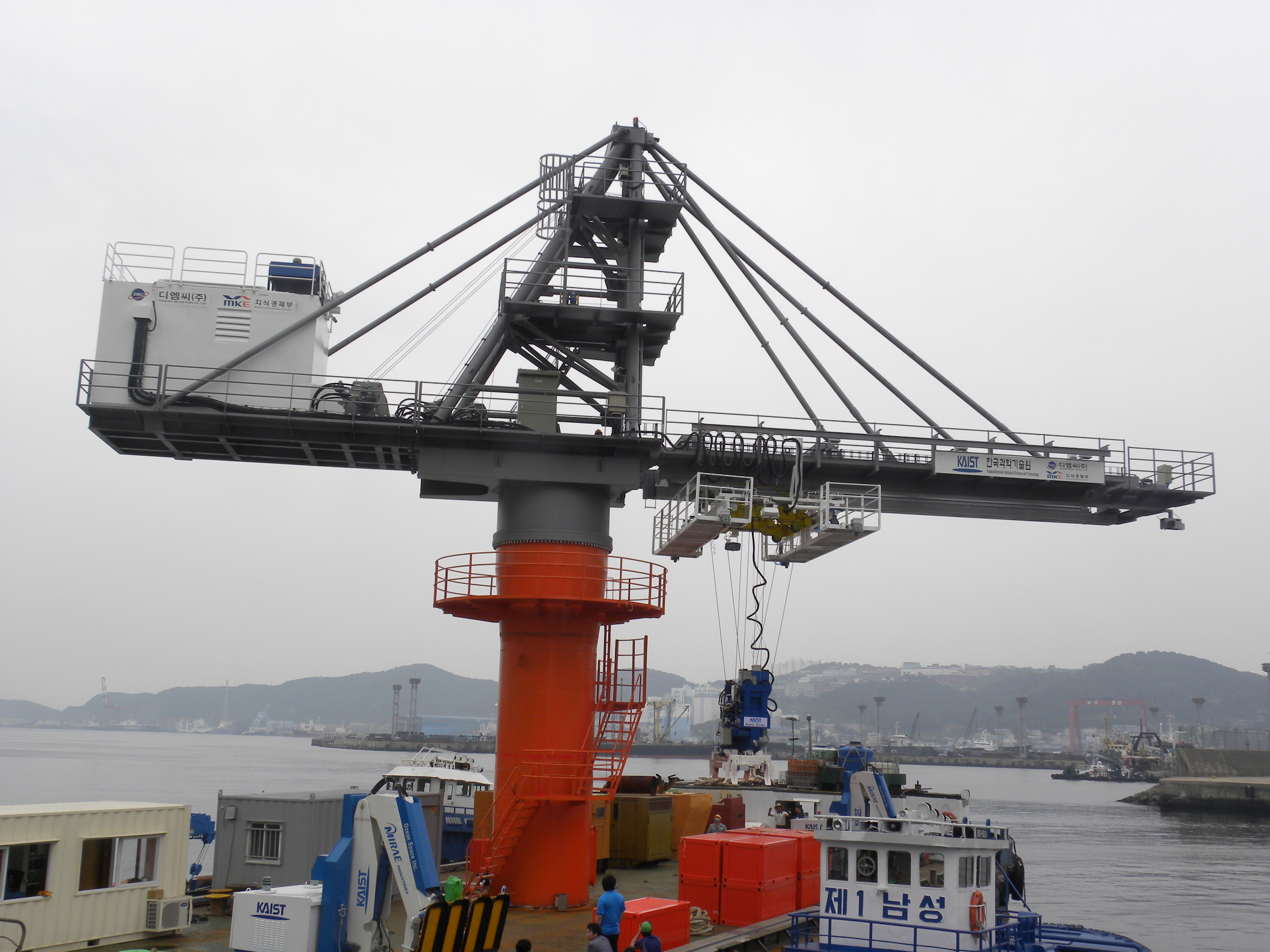 Mobile Harbor delivers the goods for container ships at sea by Reuters TV
Reuters TV introduced the Mobile Harbor showcase that was held on June 29, 2011 in Busan, Korea. For the article, please follow the link:
http://www.youtube.com/watch?v=tuADd3DqCQg
2011.07.11 View 6652
Mobile Harbor delivers the goods for container ships at sea by Reuters TV
Reuters TV introduced the Mobile Harbor showcase that was held on June 29, 2011 in Busan, Korea. For the article, please follow the link:
http://www.youtube.com/watch?v=tuADd3DqCQg
2011.07.11 View 6652